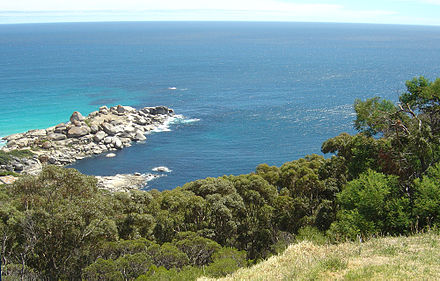Diving the Cape Peninsula and False Bay/Logies Bay - shoreline dive site at Llandudno on the Cape Peninsula west coast
The dive site Logies Bay is a shoreline rocky reef in the Llandudno area on the Atlantic seaboard of the Cape Peninsula, near Cape Town in the Western Cape province of South Africa.
Understand
See also: Diving the Cape Peninsula and False Bay#Understand
Position
- Logies Bay 📍: S34°00.25' E018°20.53'
The location is the bay to the right of Llandudno beach. It is easy to see from the car park above the turnoff to Llandudno when coming from Camps Bay. The difference between this bay and the main Llandudno bay is remarkable: whereas the main bay is a beach with the sand extending into deep water, the Logies Bay is full of kelp and rough boulders with no sand in sight. Furthermore, whereas Llandudno has a popular surfing wave, the small rocky headland tends to protect this bay and it is rare to see much of a swell come in.
This site is in the Table Mountain National Park Marine Protected Area since 2004. A permit is required. The site is within the Karbonkelberg restricted area.
Name
The name "Logies Bay" is found on maps of the area.
Depth
No data available. Probably about 10 m
Topography
The rock formations along the north shore are quite interesting in places as there are many small caverns and holes. This sort of formation extends below the water and this makes the diving interesting: the small holes are good places for marine life to settle and while not extensively covered the life on the rocks can be very beautiful. The rocky sections do not extend far beyond the shoreline and the bottom soon becomes sandy interspersed smaller boulders covered with kelp. The kelp is seldom dense enough to be a problem.
Geology: Late Pre-Cambrian granite of the Peninsula pluton.
Conditions
The site is exposed to swells from the west, and is often good during or after south easterly winds. The site is reasonably protected from south westerly swell due to the little headland, but if the swell is large or long period it will get into the bay.
The site is usually at it's best in summer but there may also be occasional opportunities in spring and autumn.
This is an area which sometimes has upwellings, caused by south easterly winds, resulting in cold clear water which may be followed by a plankton bloom.
Facilities
Off-road parking.
Get in
 See also: Diving the Cape Peninsula and False Bay#Boat dives
See also: Diving the Cape Peninsula and False Bay#Boat dives
The site is normally accessed from a shore entry.
Drive down the road to the beach parking lot. This is a summer site and there may be a severe shortage of parking on hot sunny days and particularly weekends. The little parking lot overlooks the beach, but you should notice a red dirt road leading to the right which is not accessible by car. Kit up as much as possible here and walk along this road until you reach the small bay. Getting to the water’s edge includes a short scramble down a steep slope and some boulder hopping. A small point of flattish smooth rocks extends slightly into the bay and this provides a useful entry site.
See
Marine life
See also: Diving the Cape Peninsula and False Bay#The marine ecology
An interesting phenomenon which can be observed here is the congregation of Box Jellyfish in columns. The jellyfish, which usually swim in an apparently random pattern, congregate and form a column a few metres wide at most, from the bottom to the surface over the bright sand. The jellyfish can be seen actively swimming towards these columns which are packed with the animals. These columns are more likely to be seen on the larger sandy areas.
Photography
Routes
No particular route recommended.
Stay safe
See also: Diving the Cape Peninsula and False Bay#Stay sare
Hazards
Cold water.
Skills
No special skills required.
Equipment
See also: Diving the Cape Peninsula and False Bay#Equipment
No special equipment required.
Nearby
- Het Huis te Kraaiestein 📍
- Mushroom Pinnacle 📍
- Sandy Cove 📍
- Boardroom pinnacle 📍
- Justin’s Caves 📍
- MV Antipolis 📍
- Klein Pannekoek 📍
- Groot Pannekoek 📍
- Coral Gardens 📍
- Coral Gardens Offshore Pinnacle 📍
- 13th Apostle 📍
- MV Romelia 📍
- Steps 📍
- MV Harvest Capella 📍
Back to the Alphabetical list of sites, or list of dive sites in the Llandudno area
Other regional dive sites:
Logies Bay
Timezone:MultipleCoordinates:-34.00, 18.34